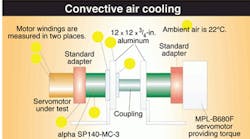Servomotor-gearhead combinations are often limited by temperature. The higher the torque load or rpm, the higher the temperature.
To improve performance, temperature must be lowered. This can be accomplished through better extraction of heat from the motor-gearhead combination.
In one solution, a special adapter connects the servomotor to the gearhead. Typical adapters are solid pieces of aluminum, but some newer adapters have an internal channel with input and output ports, allowing circulation of air or liquid to better remove heat.
The type of fluid used in the adapter channel depends on what is available at the location.
Compressed-air temperature cannot be improved much. In contrast, the use of a chiller to circulate the water through the channel can reduce water temperature — and if a water/glycol mixture is used, circulating-water temperature can be reduced significantly.
Reduction in cooling-fluid temperature increases the delta (or temperature change) of channeled-adapter cooling to a value far better than that of natural convective air-cooling.
Q&A
Is this method of cooling a proven technology?
Yes. Assume that we mate a servomotor to a gearhead at 50% torque load and 3,000 rpm. Performance improves with cooling: In this particular setup, the gearhead output bearing reaches a steady-state 87° C with natural convective cooling.
When 23° C air is run through the internal adapter channel, steady-state temperature settles at a much cooler 63° C.
When 7° C water is run through the internal adapter channel, steady-state temperature settles at 53° C.
How (specifically) do different methods of cooling compare?
Absolute temperature reported is not as significant as the delta, or difference, between the various methods of cooling.
If ambient temperature in the manufacturing plant is higher than our assumed 22° C ambient, temperatures will be higher, but display approximately the same deltas exhibited during testing.
Using compressed air as the cooling fluid, temperature is reduced by normal convective air-cooling by approximately 24°C at the gearhead output bearing. Using water as the cooling fluid reduces temperature (over normal convective air-cooling) by approximately 33° C.
Refer to the image on convective cooling: Mounting plate dimensions are taken from Rockwell Automation's MP-Series low-inertia servomotor with 100 to 1650mm frame size. To obtain the specified motor thermal rating, the motor is mounted (as instructed in literature) on a surface with heat dissipation equivalent to a 12 x 12 x 0.05-in. aluminum heat sink.
The MPL-B540K servomotor coupled to an alpha SP140-MC1-3 gearhead combination on the left is the unit under test. The servomotor-gearhead combination on the right supplies torque to the unit under test.
Eight thermocouples monitor temperatures; limiting temperature is at the gearhead output bearing, so the termocouple here is monitored to determine when steady state is achieved - defined here as no more than 1° C rise over a 15-minute period.
Are there other benefits?
Motor winding temperatures are also lowered when cooling occurs between the servomotor and gearhead, because heat is removed from both pieces of equipment.
Then the combination can be run at a higher torque load and/or rpm. Note, however, that published maximum values by the manufacturers must still be observed.
Alternatively, with a cooled adapter, a smaller servomotor may be selected and operated at a torque load and/or rpm previously not possible due to temperature limitations.
This month's handy tips provided by William Bollig of WITTENSTEIN Inc., Bartlett, Ill. For more information, visit wittenstein-us.com or call (888) 534-1222.
